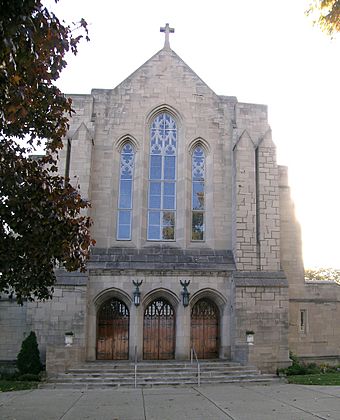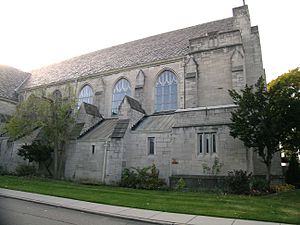Assumption of the Blessed Virgin Mary Church facts for kids
|
Assumption of the Blessed Virgin Mary Church Complex
|
|
 |
|
| Location | 13770 Gratiot Avenue Detroit, Michigan |
|---|---|
| Built | 1929 |
| Architect | Peter Dederichs Et al. |
| Architectural style | Late Gothic Revival, Renaissance |
| NRHP reference No. | 91001020 |
Quick facts for kids Significant dates |
|
| Added to NRHP | August 5, 1991 |
The Assumption of the Blessed Virgin Mary Church is a historic Catholic church in Detroit, Michigan. Most people know it by its nickname, the Assumption Grotto Church. The church community started way back in the 1830s. The beautiful building you can see today was finished in 1929. Because of its long history, it is a Michigan State Historic Site and is on the National Register of Historic Places.
Contents
Buildings and Grounds
The Assumption Grotto is more than just a church. It's a whole complex of buildings and land with a special history.
The Church Building
The main church is built in a style called Neo-Gothic. This means it was designed to look like the grand, towering cathedrals built in Europe during the Middle Ages. The outside is covered in a light-colored stone called limestone.
Inside, the church has beautiful altars and communion rails made from Italian marble. The light shines through colorful stained-glass windows. These windows show pictures of important moments in the life of the Virgin Mary and other saints.
Other Buildings and Features
Besides the church, the property has several other buildings:
- A rectory, where the priests live, was built in 1918.
- A convent, for nuns, was built in the early 1920s.
- A cemetery is located behind the church. It has gravestones dating from the 1800s all the way to today.
- A grotto, which is a small cave-like shrine, is a very famous part of the church grounds.
A large statue of Our Lady of Lourdes also stands on the property, welcoming visitors.
The Famous Grotto
The grotto is a replica of a famous shrine in Lourdes, France. It was built in 1881 using limestone. To make it special, farmers from all over Michigan brought boulders to place around the shrine. If you look closely, you can see that some of the stones have names and messages carved into them.
History of the Church
The story of Assumption Grotto begins with German immigrants who came to Michigan in the 1830s. They settled in an area north of Detroit and started a small community called Conner Creek.
The First Church
The Greiner family was one of the first to settle there. They donated land to build a small log cabin church. At first, people called it Kirchen Wald, which is German for "Church in the Woods." Later, its name was changed to the Assumption of the Blessed Virgin Mary Church.
In 1847, it officially became a parish, which is an organized church community. A few years later, in 1852, the parish built a stronger brick church that could hold 500 people.
Building the Grotto and the Current Church
In 1876, the church's pastor, Father Amandus Van Den Driessche, visited the Sanctuary of Our Lady of Lourdes in France. He was so moved by the grotto he saw there that he decided to build a copy of it in Detroit. The grotto was finished in 1881 and quickly became a popular place for people to visit and pray. In 1882, Pope Leo XIII even announced that visitors to the grotto could receive special blessings.
By the early 1900s, Detroit was a fast-growing city, and the parish grew with it. After the brick church from 1852 burned down, the community needed an even bigger building. The current church was designed and built between 1928 and 1929. It was officially opened on September 22, 1929.
The Church Today
Because its grotto is so well-known, most people now call the church "Assumption Grotto." It is still an active parish today. The church is famous for holding services in both English and the traditional Latin, which is not very common. This makes it a unique place of worship in the Archdiocese of Detroit.
See also
 In Spanish: Iglesia de la Asunción de la Santísima Virgen María para niños
In Spanish: Iglesia de la Asunción de la Santísima Virgen María para niños
- Roman Catholic Archdiocese of Detroit


